15 Effective Internal Communication Ideas for Team Collaboration

Are you struggling to cut through the noise of day-to-day operations to deliver clear, impactful messages to your team? How often do you find your carefully crafted updates lost in the sea of emails, or your announcements falling on disengaged ears?
Your mission is to knit together a diverse workforce into a cohesive unit that’s informed, engaged, and aligned with the organization’s goals. With a blend of creative internal communication ideas, innovative campaigns, and the right chosen media, you can transform the way your business communicates internally.
In this article we’ll list actionable strategies and examples designed to revitalize your internal communication – whether it’s launching a campaign that sparks conversation, or leveraging new media to connect with your team on a deeper level.
What is Internal Communication?
| Internal communication is the exchange of information and ideas within an organization – from formal announcements and policies to informal chats and social interactions. |
It plays a crucial role in keeping employees informed, engaged, and aligned with the company’s goals and values. Effective internal communication can foster a collaborative and positive work culture, improve employee morale, improve communication skills and boost productivity.
There are various types of internal communication:
- Formal channels include emails, memos, newsletters, and company-wide meetings. For example, a company-wide email can be used to announce important updates or changes.
- Informal channels include watercooler conversations, team meetings, and instant messaging platforms. For example, a team meeting can be used to discuss project progress and brainstorm ideas.
Why Internal Communication Matters
Internal communication is the backbone of a successful organization. It ensures that employees are well-informed about company goals, strategies, and updates, fostering transparency and alignment.
Effective internal communication can boost employee morale, team communication and engagement, and productivity, as it creates a sense of belonging and purpose. It helps prevent misunderstandings, conflicts, and silos within the organization.
13 Internal Communication Ideas to Transform Your Workplace
1. Implement Collaborative Communication Platforms
Implementing collaborative communication platforms like Beekeeper can greatly enhance internal communication in an organization. Beekeeper is a leading communication platform that enables seamless and efficient communication across teams and departments. It provides a centralized hub for employees to share information, collaborate on projects, and stay connected.
With Beekeeper, employees can easily access important updates, documents, and company news in real-time, eliminating the need for lengthy email chains or searching through multiple platforms. The platform also offers instant messaging and group chats, allowing for quick and effective communication among team members.
Beekeeper’s mobile app ensures that employees can stay connected and engaged even when they are on the go. It provides a user-friendly interface and supports multilingual communication, making it suitable for organizations with diverse teams or remote workers.
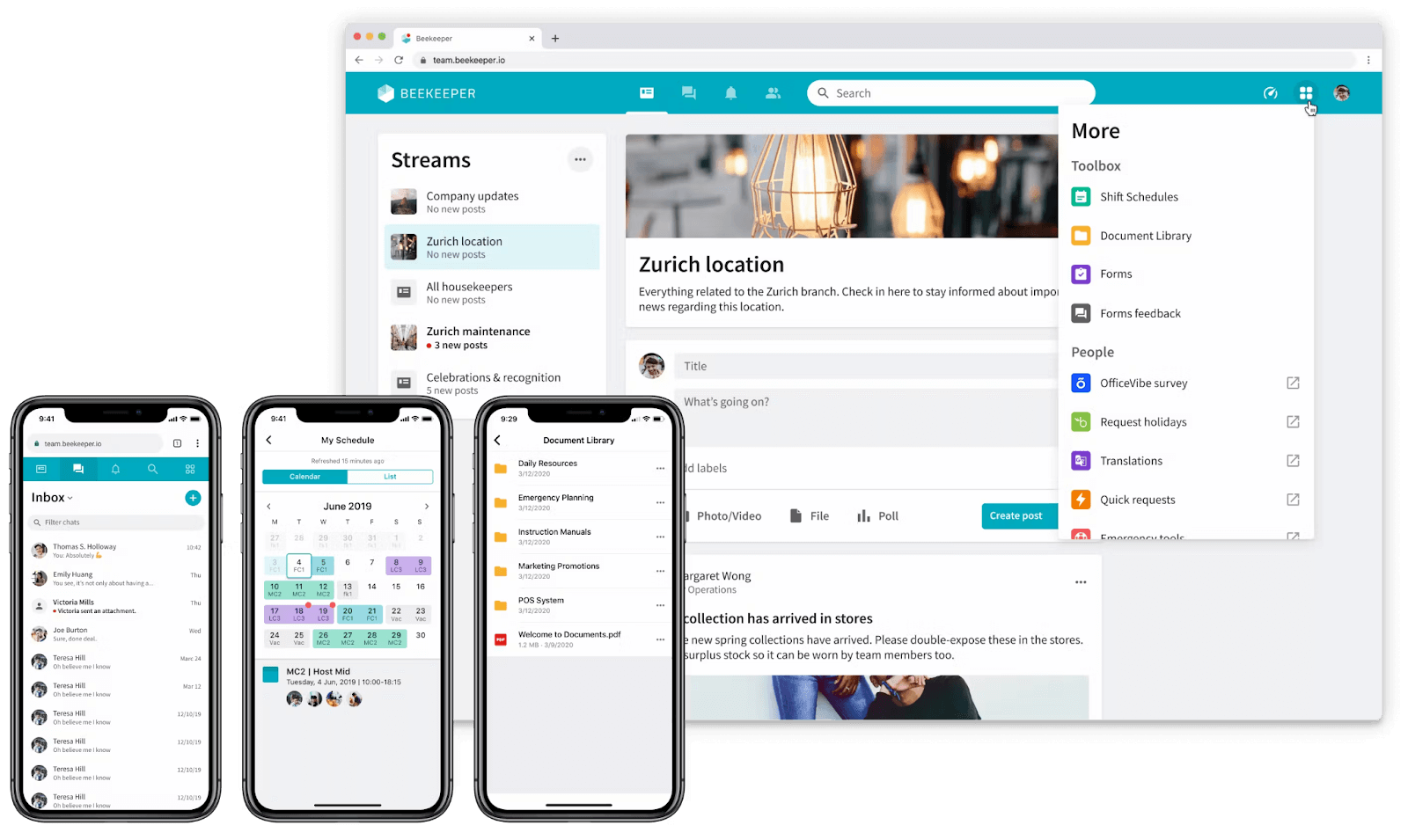
Source: Beekeeper
Embrace AI for Personalized Communication Experiences
Embracing frontline AI can significantly enhance customer engagement and satisfaction. AI-powered chatbots and virtual assistants can provide personalized recommendations, answer customer queries, and even anticipate their needs. These intelligent systems can analyze customer data and preferences to deliver tailored messages and offers, creating a more personalized experience.
Also, AI can analyze customer interactions to identify patterns and trends, enabling businesses to make data-driven decisions and improve their communication strategies. By leveraging AI, organizations can create seamless and efficient communication experiences that not only save time and resources but also build stronger relationships with customers.
At Beekeeper, we wanted to give frontline manager’s another tool in their toolbox when it comes to staying in touch with their distributed teams. Although we support and encourage feedback surveys, we created a Frontline Intelligence package that uses AI-powered sentiment analysis to give a snapshot of how employees are feeling without asking directly. Here’s what that looks like:
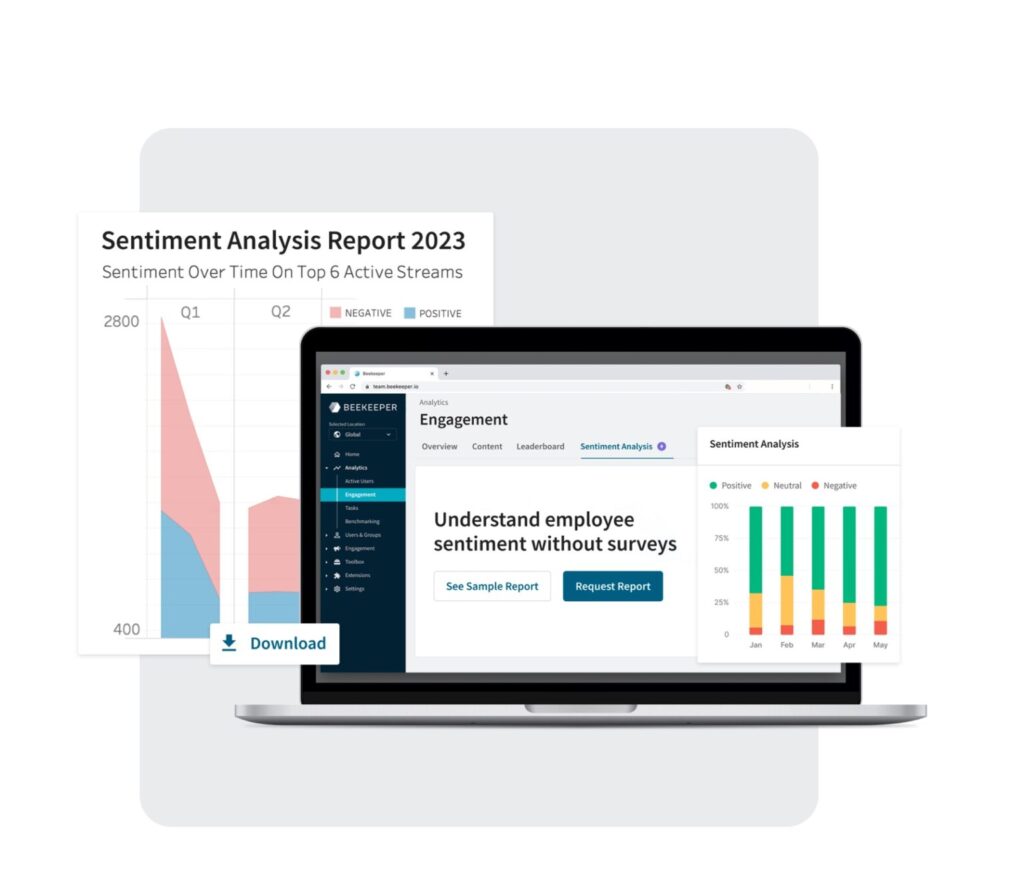
Source: Beekeeper
2. Making Messages Pop with Multimedia Integration
Multimedia integration refers to the process of combining different forms of media, such as text, images, audio, video, and interactive elements, into a single cohesive presentation or experience.
Let’s look at how Beekeeper lets users add multimedia in Streams and posts.
In Beekeeper, Streams are news feeds that can be set up based on topic or structure (like a department or team). You can upload images, videos, GIFs and documents within each post in a Stream. For example, if your organization is hosting a live event, you can simply insert a link to the live stream into your company news feed. Employees working remotely or in different locations can still watch live and stay updated on mobile.

Source: Beekeeper
Platforms with multimedia integration capabilities allow organizations to have a wider set of tools to convey information more effectively. Sometimes, text is best, but often a photo, video, or a combination of all three is a better way to connect with employees.
3. Crafting Eye-Catching Responsive Email Templates
To create eye-catching templates, start with a clean and simple layout that is easy to navigate. Use contrasting colors and bold fonts to highlight important information and calls to action. And try to incorporate high-quality images that are optimized for different screen sizes.
Make sure your templates are mobile-friendly by using responsive design techniques that automatically adjust the layout for different screen resolutions. Also be sure to test your templates thoroughly on different devices and email clients to ensure they render correctly.
Here’s an example of what an email template might look like for internal newsletters:
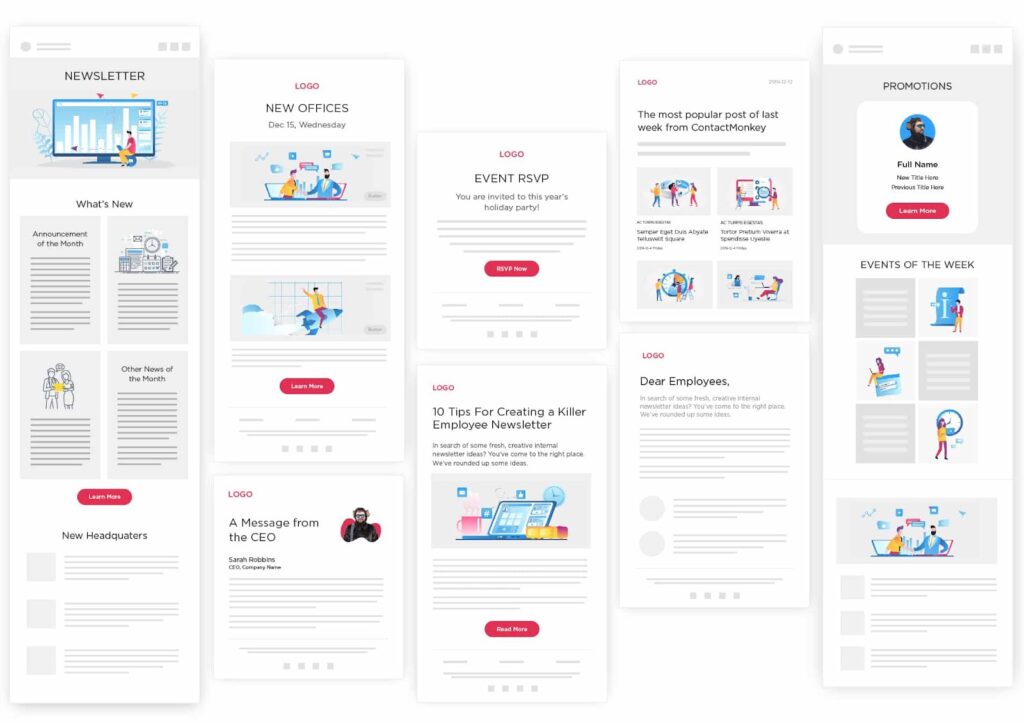
Source: ContactMonkey
4. Gamifying Communication with Challenges and Leaderboards
Gamifying communication is an innovative approach to boosting engagement and participation within teams and organizations. By incorporating game mechanics into communication platforms, such as chat or project management tools, employees are motivated to actively contribute and collaborate.
| One study found that 87% of US workers said gamification would help them be more motivated and productive, with 80% saying that gamified learning helped keep them more engaged than traditional training. |
P.S. One of Beekeeper’s integrations includes MobieTrain, a mobile-first microlearning platform that incorporates gamification into workplace training.
Challenges can be set up to encourage specific behaviors or tasks, with points or rewards given for completion. Leaderboards display rankings, fostering healthy competition and driving individuals to strive for excellence.
This gamified approach not only makes communication more fun and enjoyable, but also increases workforce productivity and teamwork. It creates a sense of achievement and satisfaction, ultimately enhancing overall communication and collaboration within the organization.
5. Podcast Series for On-the-Go Internal Updates
A podcast series for employees is a convenient and effective way to keep teams informed and engaged. By delivering updates through audio content, employees can stay up-to-date while multitasking or during their commute.
This format allows for easy consumption, as employees can listen at their own pace and convenience. Podcasts also provide a personal touch, as leaders and experts can share insights, stories, and important information in a conversational manner. The series can cover a variety of topics, such as company news, industry trends, and employee spotlights. A podcast series enables organizations to deliver internal updates in a dynamic and accessible way, fostering continuous learning and connection among employees.
6. Weekly Themed Photo and Video Sharing Contests
Weekly themed photo and video sharing contests are a fun and interactive way to engage employees and encourage creativity. Each week, a new theme can be announced, such as “favorite workspace setup” or “team bonding activities.” Employees then have the opportunity to capture and share their photos or videos related to the theme.
This sparks excitement,friendly competition, promotes collaboration and a sense of community. Employees can vote or provide feedback on their favorite entries, fostering engagement and interaction. The contests can be accompanied by prizes or recognition for the winners, further motivating employees to participate.
At Beekeeper, we saw one of our clients embrace photo sharing to really elevate their employee recognition program. Viejas Casino & Resort used Beekeeper to create a Stream where employees could post photos of themselves holding the recognition cards they receive. Freddie Harmon of Viejas said that this not only quadrupled the amount of recognition happening, but it also created the highest levels of cross-department camaraderie he’s seen. Here’s a glimpse of what it looks like in Beekeeper:
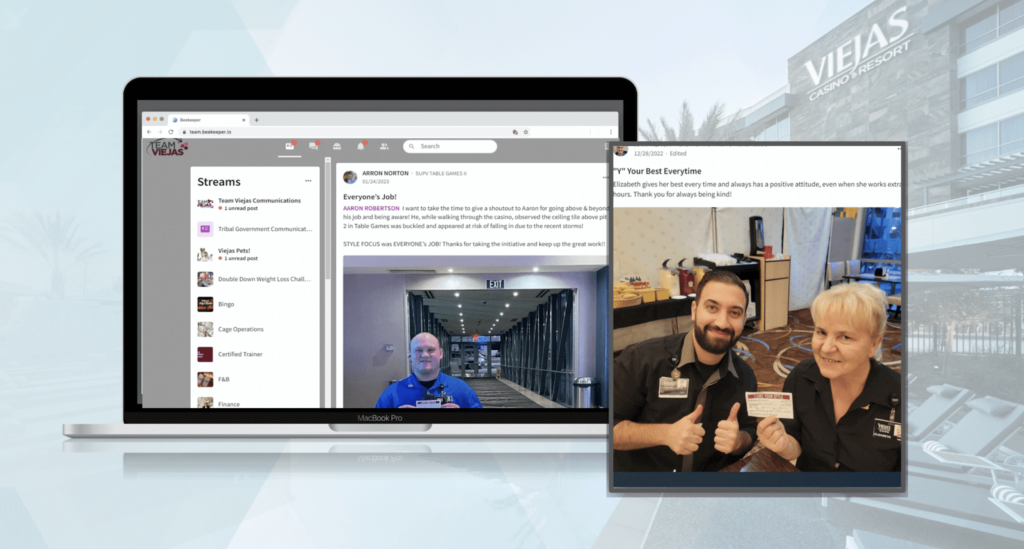
Source: Beekeeper
7. Virtual Town Hall Meetings with Employee Q&A Sessions
Virtual Town Hall Meetings are an effective way to foster open communication and engage employees in the decision-making process. These interactive virtual meetings provide a platform for leaders to share updates, goals, and strategies with the entire organization. Employees have the opportunity to ask questions, provide feedback, and gain insights into the company’s direction. This transparent and inclusive approach creates a sense of belonging, as employees feel valued and heard.
Virtual Town Hall Meetings can be conducted through video conferencing platforms, allowing for real-time interactions and participation from remote or geographically dispersed teams. This communication strategy promotes transparency, collaboration, and strengthens the bond between leadership and employees.
8. Employee Recognition and Appreciation Program
Employee recognition is essential for maintaining employee morale, motivation, and satisfaction. Recognition programs aim to acknowledge and reward employees for their hard work, dedication, and achievements. By recognizing and appreciating their contributions, employees feel valued and motivated to continue performing at their best.
These programs can include initiatives such as employee of the month/year awards, peer recognition programs, or spot recognition for exceptional performance. They can also include monetary rewards, gift cards, or other incentives to further express appreciation. By implementing these programs, organizations cultivate a positive work culture, boost employee engagement, and foster a sense of loyalty and commitment among their workforce.
At Beekeeper, we’ve seen just how impactful a strong recognition program can be. We worked with Conrad Hotels & Resorts to incorporate a mobile-friendly internal communication approach to their frontline hospitality workplace. One aspect of that approach included digitizing their recognition program, which had a positive impact on both the quality of service and the cleanliness of guest rooms:
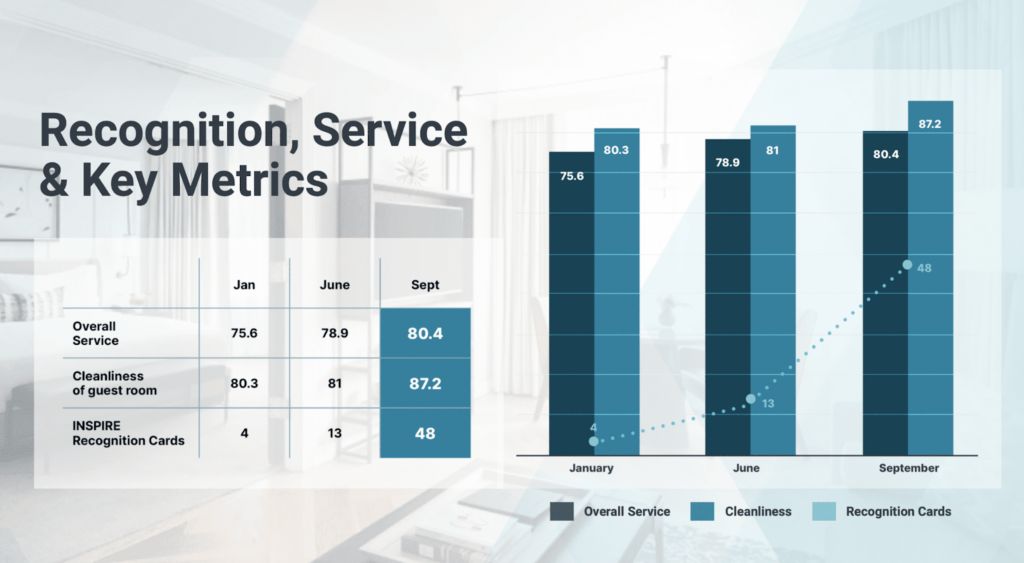
Source: Beekeeper
9. Employee Insights and Success Stories
Sharing employee insights and success stories is a powerful way to inspire and motivate employees because sharing these stories allows employees to learn from their colleagues’ experiences, gain insights into different roles and departments, and understand the impact their work has on the organization.
By highlighting success stories, organizations can recognize and celebrate individual and team achievements, fostering a culture of collaboration and continuous improvement. These stories can be shared through newsletters, internal communication platforms, or during team meetings. They not only inspire employees but also create a sense of pride and unity, as employees see the tangible results of their efforts and the collective success of the organization.
10. Internal Social Media Opportunities for Networking and Collaboration
Internal social media opportunities provide a valuable space for networking and collaboration within organizations, allowing employees to connect, share ideas, and collaborate on projects. This provides a space for employees to engage in discussions, ask questions, and seek advice from colleagues across different departments or locations.
It also facilitates knowledge sharing and promotes cross-functional collaboration, breaking down silos and fostering a culture of teamwork. By providing a user-friendly and accessible platform with these opportunities, organizations can encourage employees to connect and collaborate, enhancing communication, innovation, and overall productivity within the organization.
11. Employee-led Webinars or Workshops on Industry Trends and Skills Development
Employee-led webinars or workshops are a valuable way to promote learning and professional growth within organizations. These webinars or workshops are led by employees who are subject matter experts in their respective fields, offering insights and knowledge to their colleagues.
By creating a platform for employees to share their expertise, organizations not only encourage continuous learning but also foster a culture of collaboration and knowledge sharing. These sessions provide employees with the opportunity to stay updated on industry trends, learn new skills, and enhance their professional development, ultimately benefiting both the individual and the organization.
12. Employee Feedback Surveys and Action Plans for Continuous Improvement
Employee feedback surveys are valuable tools for organizations to gather insights on employee experiences, engagement, and satisfaction. These surveys provide employees with an opportunity to voice their opinions, concerns, and suggestions, allowing organizations to identify areas for improvement.
However, the real value lies in the action plans that follow these surveys. Once the survey results are analyzed, organizations can develop action plans to address the identified issues and implement changes that will lead to continuous improvement.
These action plans should involve clear goals, specific strategies, and measurable outcomes. Regularly reviewing and updating these action plans ensures that organizations are proactively responding to employee feedback and striving for a better work environment.
At Beekeeper, we wanted to give frontline managers the tools they need to gather feedback from remote teams and see the results in a way that’s easy to understand and take action on. Here’s what the results of an employee satisfaction survey looks like:
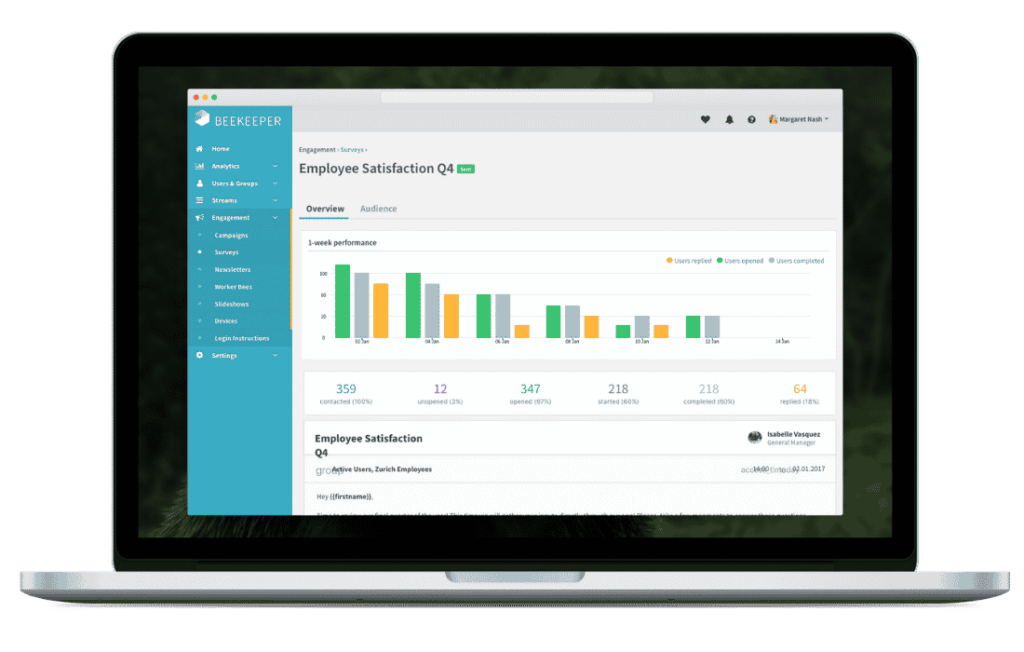
Source: Beekeeper
13. Virtual Coffee Chats or Lunch Breaks for Informal Networking and Relationship Building
Virtual coffee chats and lunch breaks allow employees to come together in a relaxed setting to discuss common interests, share personal experiences, and brainstorm innovative ideas. This informal interaction helps create a supportive and collaborative work environment where employees feel comfortable expressing their thoughts and opinions.
This kind of break provides a platform for employees to engage in non-work-related conversations, promoting social bonds, breaking down communication barriers, and helping employees build meaningful relationships beyond their professional responsibilities.
Virtual networking opportunities also facilitate mentorship and collaboration within the organization. Employees can seek guidance and advice from more experienced colleagues during coffee chats or lunch breaks, leading to knowledge transfer and professional development.
Engage Your Team with Innovative Communication Ideas
Engaging your team with a well-rounded internal communication strategy is crucial for keeping them informed, motivated, and connected. At Beekeeper, we want to give frontline teams the tools to create a customized communication strategy that incorporates innovative ways to connect employees.
Beekeeper allows organizations to streamline communication, share important updates, and provide real-time feedback to their frontline employees. With features like chat, surveys, Streams, and Beekeeper campaigns, the platform enables seamless communication between team members, regardless of their location. Beekeeper enables frontline organizations to bridge the communication gap between frontline workers and the rest of the team, leading to improved collaboration, increased productivity, and a more connected workforce.
Learn more about connecting your frontline teams!

About the author
Beekeeper
We make frontline lives easier, work safer, and teams more connected so businesses can reach new heights. At Beekeeper, we’re dedicated to making frontline lives easier by connecting workers with the tools, support, and information they need to feel valued, do their best work, and drive the business forward.







